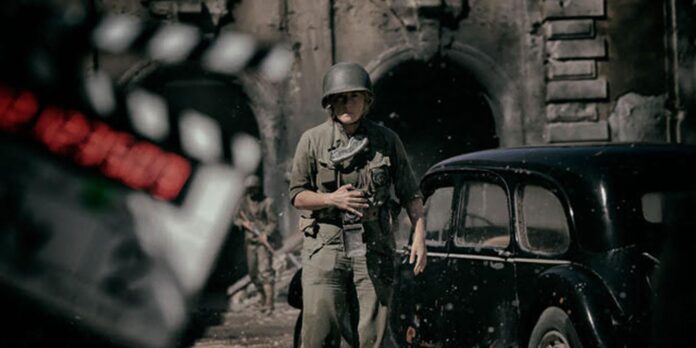“A woman who has the agency a camera brings is still a sight to behold,” reflected filmmaker Kirsten Johnson in the brochure for Film at Lincoln Center’s 2018 retrospective The Female Gaze. Among the female directors of photography included in the survey was Ellen Kuras, director of photography of Eternal Sunshine of the Spotless Mind and Tom Kalin’s New Queer Cinema landmark Swoon, among other titles. Kuras has now directed her first fiction feature, a film about another woman who inverted the male gaze and explored “the agency a camera brings”: the Surrealist photographer and war correspondent Lee Miller.
By 1938, when the action of Lee begins, Miller had developed darkroom techniques with Man Ray, run her own commercial studio and been exhibited in the Brooklyn Museum. But the Miller we meet in the film is a self-described former “model, muse, ingénue” yet to find her voice. It is not hard to see why the material appealed to Kate Winslet (who also served as a producer), subject of adoring screen close-ups since her teens and now forging her path in the entertainment industry as an independent-minded artist increasingly alienated from narrow standards of desirability.
The film, which had its world premiere this past weekend at the Toronto International Film Festival (Tiff), follows Miller’s discovery of that voice as a photographer with British Vogue during the Second World War. She worked under the editorship of Audrey Withers (Andrea Riseborough) and often in concert with Life’s David Scherman (Andy Samberg), both of whom greet Miller, upon their initial meeting, by immediately and clearly stating their first and last names, as all real-life historical figures must upon their entrance into a biopic.
The film is framed, with depressing inevitability, by an interview between the protagonist in old-age makeup and a callow interlocutor played by a too-famous actor (Josh O’Connor, in this case). Old Lee holds our hands through the chronology of the film, offering quick historical thumbnails—she received her accreditation to cover the American, rather than British armed forces, because Americans were “less bound by tradition”—to go along with anachronistically helpful dialogue about how the Germans are “brainwashed” by this worrying Hitler fellow.
The film, adapted from the legacy-cementing biography The Lives of Lee Miller, by her son Antony Penrose,restages many compositions from her photographic archives, seen in candids and photojournalism that accompany the end credits. But it is hardly immune to the glaringly inadequate historical compressions that are par for its genre. Samberg is given about 60 seconds to process the whole Holocaust.
As Miller follows Allied troops through war zones and liberated Paris, into Hitler’s bathtub and the death camps, the film is interested in her primarily as an empowered storyteller, more so than as an artist. Kuras avoids the shutter-click-and-still-image cliché of many films about photographers, but her treatment of Miller’s process is equally unsatisfying, with shot-reverse shot patterns often quickly establishing a scene in wide shot before lingering on an emotional Winslet, camera in hand, contemplating the object of her attention. When Scherman holds up a reflector to fix an underlit setup it’s the only real acknowledgement of lighting’s role in Miller’s art; we occasionally see her fussing over framing and composition, or interacting with her subjects to draw them out, but in dialogue that invariably circles back to the film’s thematic preoccupations rather than digging into the transaction between photographer and subject—a heavily bandaged soldier in hospital jokes that readers won’t want to see his ruined visage, but Miller promises him he’ll be in the magazine.
The film invites us to “share her journey”—to quote the name of a tribute Tiff bestows annually on a famous female guest, this year Patricia Arquette—as Miller bears witness to a history that many, as one character marvels, “never knew”. It also exaggerates Miller’s erasure, dramatising British Vogue’s decision not to publish her photos of Buchenwald and Dachau before an end-title card acknowledges that Life published the pictures in the US the following year.
Whether taking intimate shots of Women’s Auxiliary knickers drying in a barracks, or the punishment of a femme tondue, Miller’s female gaze is a window into the previously unseen—but this is personalised and narratively streamlined, always circling back to a private trauma heavily hinted at throughout the movie by Winslet’s searching gaze and an overutilised somber score by Alexandre Desplat, before a late monologue finally reveals Miller’s own childhood abuse. With Winslet’s embittered delivery of a line about how “they always get away with it”, the scene becomes her #MeToo moment and Oscar clip, filmed in a single-take close-up—but it feels paradoxical and insufficient, this decision to pay tribute to a woman who dared to pick up a camera by putting her back in front of the lens.
- Lee, 12 September at 12:50pm, Scotiabank Theatre Toronto, Toronto International Film Festival (wide release to follow)

























